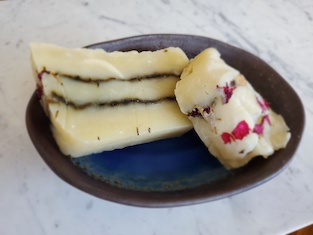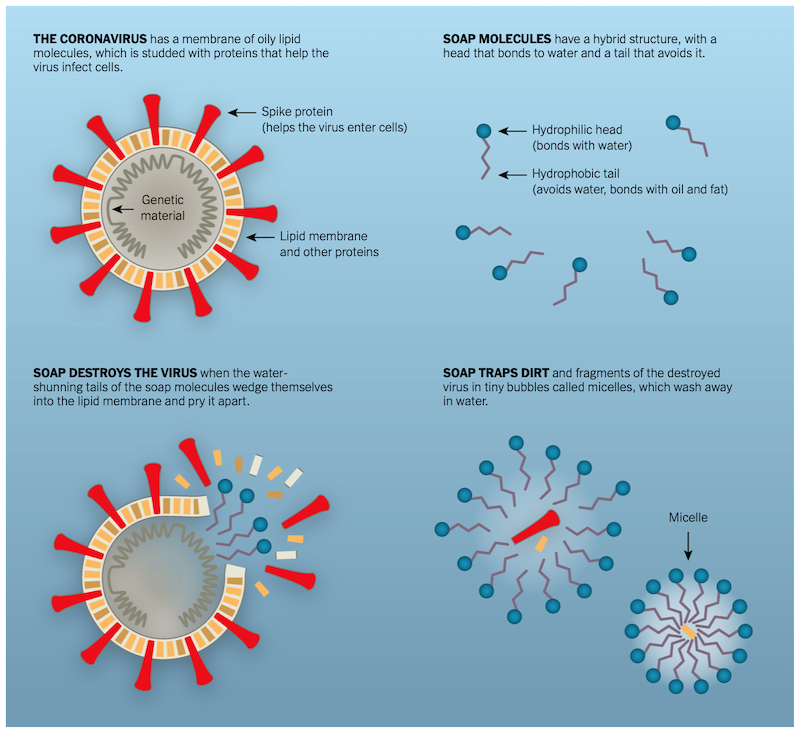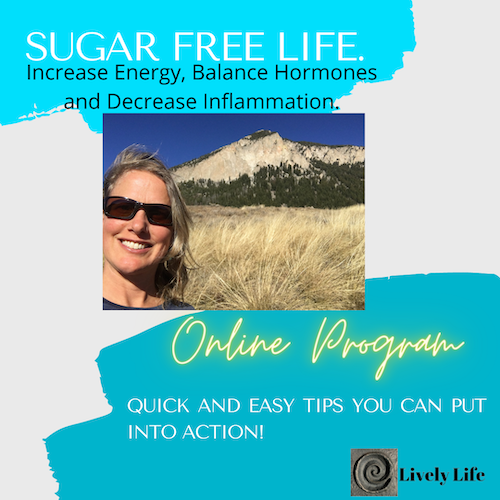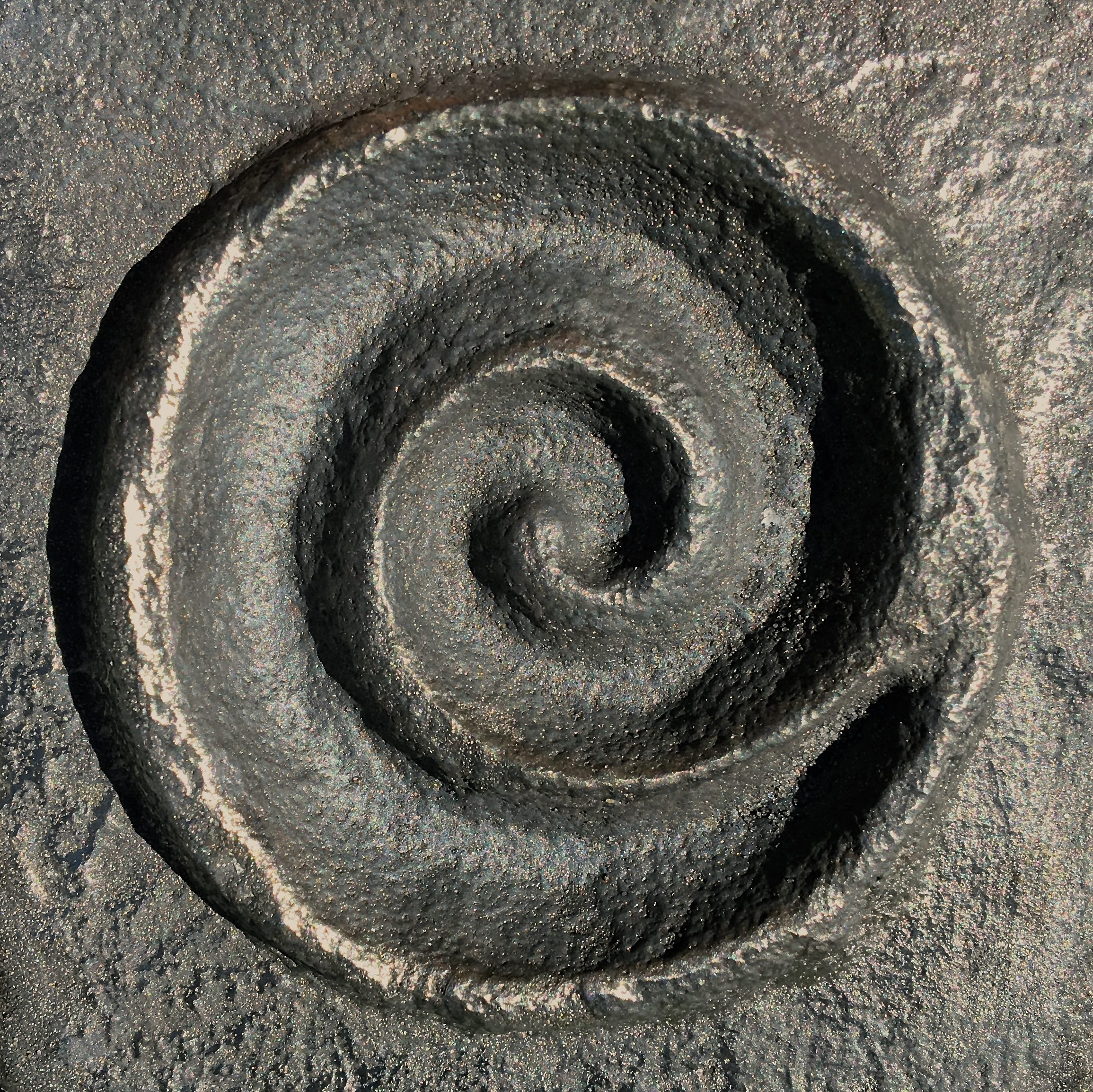Soap! Our best defense to viruses and bacteria

We started making our own soap in 2017, now we take our soap on trips with us cause we love it! We thought it would be a great time to share our recipe since you may have time at home right now to try making the recipe. SOAP is the number one way to prevent the coronavirus – washing your hands. To help flatten the curve and decrease the effect of the pandemic and to stay healthy.
Safety First!
Making soap is chemistry in the kitchen. Be safe and wear protective glasses and gloves when working with lye. Lye must be added to the water. Do not let children near the lye or the water with lye mixture, it is corrosive and dangerous.
A Little Chemistry
Soap is a pin like structure with hydrophobic (water-hating) and hydrophilic (water-loving) sides to it’s structure. You create this structure through the “saponification” process of combining oil (triglycerides – hydrophobic) with sodium hydroxide (food grade lye) to produce glycerol and a fatty acid salt called “soap”.
Washing with soap and water is an effective way to destroy and dislodge many microbes, including the new coronavirus. As shown by this great diagram from New York Times by Jonathan Corum and Ferris Jabr.


SPRING CLEANSE 2025 : SUGAR FREE LIFE – Blood Sugar Balance.
Increase Energy, Increase Immune System, Balance Hormones, Lose Weight and Decrease Inflammation.
Balancing blood sugar is number one step to Balancing Hormones and decreasing Inflammation! And leads to INCREASE ENERGY to live your life. A More Lively Life!
Inflammation is the #1 underlying cause of diseases and illness.
This course will give easy instructional steps to reduce sugar cravings, give substitutes, introduce healthy eating habits that will satisfy you.
ONLINE PROGRAM – available on demand with videos, information, and workbook. SPRING CLEANSE!!! This 7 week group course starts March 19th to April 23rd. March 24th to March 31st for strictest CLEANSE, March 24th to April 9th for Full 17 day cleanse. In addition you learn how to make fermented foods!
Zoom group meetups are March 19th to April 16th (April 23rd potentially or later date), then at 7:30 ET, 5:30 MT for at most 45min.
$50 off before March 19th! Additional $100 ($50 per friend) off with coupon – email me for coupon at he***@********fe.co or under contact. Thanks!

Basic Soap - Hot Process (Palm Oil Free)
Ingredients
- 8 ounce Coconut Oil unrefined preferred
- 8 ounce Shea Butter
- 13 ounce olive oil pomace or plain olive oil
- 3.2 ounce Castor Oil
- 4.4 ounce Lye Wear Protective Protection
- 12 ounce Distilled Water
- fragrance of choice 60 drops of essential oil or 1 tsp of soap fragrance oil
Instructions
- You will need a kitchen scale, kitchen thermometer, crock pot, safety glasses and gloves.
- Do not have children around for this recipe. The lye is very corrosive and dangerous. The lye is completely reacted after being in the crock pot for 35-55 min with the oils.
- Under the kitchen fume hood. Put on protection (glasses and gloves). Measure distilled water, I use a 2 cup glass measuring cup for one bread pan size. Measure the lye in a different container and PUT INTO the measured Distilled Water in a Thick glass container. DO NOT ADD THE WATER TO THE LYE (this is really important). Stir with stainless steel or wooden spoon. It will heat to around 200 degrees F (93C), it is an exothermic reaction. Now wait for this to cool to 100 to 120 degrees F (38-49C).
- Put slow cooker on low (use medium heat if you have it). Measure each oil and put into crock pot. You can cut shea butter into smaller pieces or mash with potato masher in slow cooker to help it melt faster. Want the oils to get to 100-120 degrees F (38-49C) at the same time as the lye solution decreases to this temperature range.
- Once the oils and lye solution are between 100-120 degrees F or 38-49 C (ideally within 10 degrees F or 5 C of each other). Pour the lye solution into the oils in the crock pot. The clear oils will start to turn yellow.
- Use a metal, plastic spatula or wooden spoon to stir the lye solution into oil. Once evenly mixed, carefully use an immersion blender keeping it below the liquid so it does not spray, the lye is still dangerous. You can use hand whisk or use a hand blender or constant stirring if you don't have an immersion blender. Blend until the liquid is opaque and then thicken to trace. Trace means that the mixture has thickened enough that when you drizzle some on the top of the mixture, it leaves a trail (trace) on top.
- Rinse container that the lye solution was in and utensil with white or other vinegar to neutralize.
- Cover and keep on low heat to allow the liquid to thicken. Check every 15 minutes. Once the entire surface is bubbly and the sides collapse (30-60 minutes, depends on crock pot).
- Mix the soap until smooth with a spoon. Now you can add a fragrance if you want to. Add 60 drops of essential oil or a teaspoon of soap fragrance oil (cheaper option). Use whatever scents you like and write down how much fragrance you use so you can use more or less with your next batch. I use no scents or fragrance.
- Cover mold or bread pan with parchment paper and put soap into pan. You can make layers with dried flowers or leaves. This makes the bars more visually appealing and makes the soap more exfoliating.
- Let sit for 24 or 48 hours then cut into desired soap size. Use immediately or preferred to let dry for 1-2 weeks, it hardens.
- If you really love making soap, there's lots of soap making specialist. Specialists use a soap calculator when creating new recipes. http://soapcalc.net/calc/SoapCalcWP.asp
